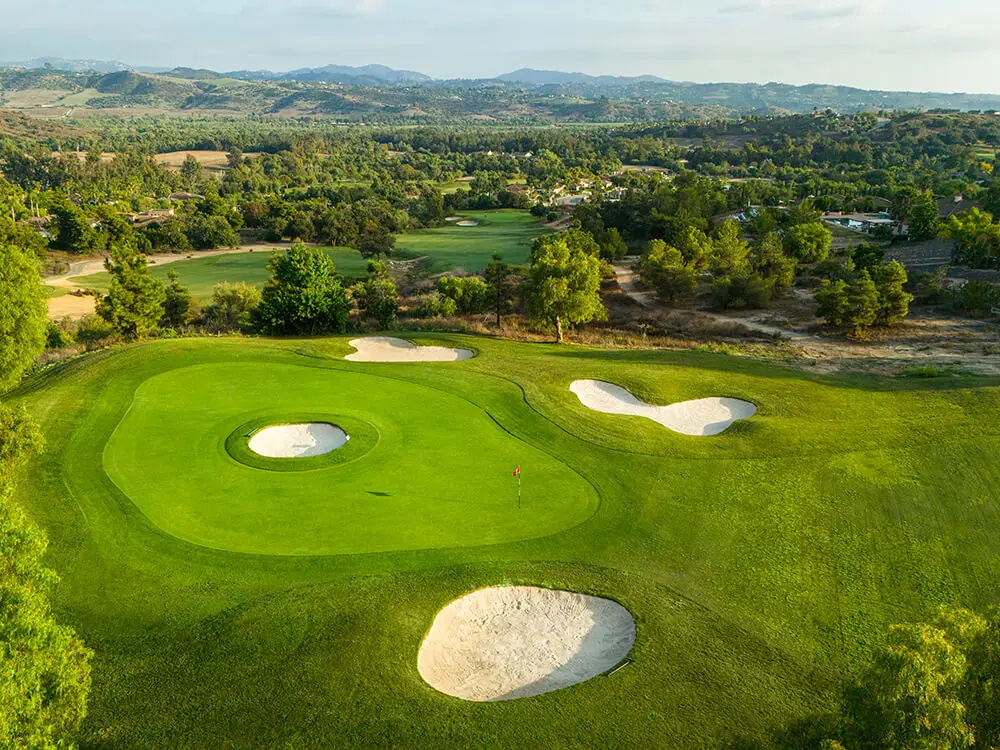When George Thomas designed Riviera Country Club’s championship layout during the late 1920s, he introduced a unique element that gave the course instant notoriety: a pot bunker set smack dab in the middle of the par-three 6th hole’s putting surface. Since then, the design feature has been replicated in other parts of the country (and world)—not to the same extent as other more famous templates, such as the Redan and Biarritz, mind you—but several examples can be found across the country.

Both Andy Staples and the team of Coore & Crenshaw recently constructed odes to Riviera as a part of their short courses at PGA National (The Staple) and Streamsong Resort (The Chain), respectively. Years ago, the late Tom Weiskopf added a bonus hole at the conclusion of Forest Dunes’s eponymous course, which sports a donut-like green complex. And in Scottsdale, the short course at Mountain Shadows features a double green with a central bunker that challenges golfers on back-to-back holes.
Greg Norman even built a pot bunker into the green on the par-four 12th hole at Doonbeg Golf Club (now known as Trump International Golf Links) in 2002; however, the bunker was removed during a redesign about a decade later, largely due to the excessively penal nature of the feature—we didn’t say every subsequent attempt after Thomas’s invention was a success.

Nevertheless, here we spotlight five noteworthy examples of the design, including the still-unmatched original.
Riviera Country Club (Pacific Palisades, Calif.)—6th hole
What makes the 6th hole at Riviera so iconic—and so successful—is not just the pot bunker at the center of its green, but the significant contours and levels of that green. They’re what make front and back-left hole locations captivating but also playable (with a putter) even if a golfer’s ball were to be stymied by the sand-filled hazard. “It’s such a unique hole,” Jordan Spieth once said of the par three. “You almost have two different par threes, so you get two holes in one.”
Stewart Cink expanded on that concept: “There’s a back-left pin that looks like a really intimidating shot, but there’s a lot of room around the green that will kind of funnel the ball back to the hole,” he explained. “That’s always been a fun shot to hit. You anticipate the excitement of a five or six iron to that pin.”

Oaks Course at TPC San Antonio (San Antonio, Texas)—16th hole
Almost two months after the PGA’s best descend on Riviera for the Genesis Open each February, the Tour shines a spotlight on another internally bunkered green, this one the par-three 16th at TPC San Antonio. The handiwork of Greg Norman, this one-shotter mirrors Riviera’s in approximate distance off the tee, but it features a putting surface that’s about 2,000 square feet larger. Bigger doesn’t mean better, however. In this case, the added area means that hole locations can be positioned further away from the central bunker, which mitigates some of the par three’s inherent drama. The green is also significantly flatter, which constrains a player’s creativity once they’re on the putting surface. Sure, the expansiveness of the green and its more benign topography allows Tour pros to cleanly pick balls off the short grass with a wedge—should they find that the bunker is intercepting their direct line to the hole—but, in my opinion, the intrigue of a central bunker inside a green is rooted in how a player can navigate around it with a putter in hand.

White Course at Dismal River (Mullen, Neb.)—10th hole
There’s no shortage of sand at Dismal River. Positioned within a sprawling swath of Nebraskan sand hills, the Jack Nicklaus-designed White Course dynamically juxtaposes green grass against sandy dunes. “The experience of arriving at the Dismal River site was like stepping back in time and seeing what the dunes of northeast Scotland must have looked like a hundred years ago,” Nicklaus says. “In every direction I looked, I saw great golf holes.”
As if you didn’t already have enough sand to contend with on the White Course, the Golden Bear added a bunker at the core of the 10th green. Ironically, this par three, which can play as long as 190 yards or as short as 95, suffers in the opposite way of the 16th at TPC San Antonio. Its mounding and contours surrounding that bunker are so severe that three-putts can often feel like a victory.
The green at the controversial par-3 10th at Dismal River White consists of three interconnected lobes around a center bunker. The rear section is sunken below the level of front two and blind from the tee. Certainly a memorable hole, but a curious design decision for sure. pic.twitter.com/HC6r3DWF1f
— LinksGems Golf Photos (@LinksGems) September 25, 2018
The Golf Club of California (Fallbrook, Calif.)—7th hole
By the time they reach the 7th hole at The Golf Club of California, golfers will have experienced half a dozen holes enhanced by ancient oaks, sycamores, and towering eucalyptus trees lining the fairways, not to mention red-top grasses and colorful wildflowers. While they may have encountered a white-sand bunker or two along the way—the opening third of the course averages two and a half bunkers per hole—golfers will meet a more daunting challenge on the 189-yard 7th. Although three sprawling bunkers guard both sides of the green, it’s the more diminutive sandy hazard in the center that can cause the biggest problems. Back hole locations, in particular, require precision off the tee, since some areas of the green beyond that bunker are only eight paces deep.

Shadow Ridge Country Club (Omaha, Neb.)—13th hole
If you’re a member of Shadow Ridge Country Club inside The Ridges private residential community in West Omaha, Neb., you’ll want to take advantage of the club’s short-game practice complex, which features a 15,000-square-foot putting surface and—more importantly—multiple practice bunkers. The latter will present a vast assortment of sand shots, all of which could come in handy when you play the private club’s 13th hole. Measuring no more than 156 yards, this par three may look like an attackable hole on paper, but with a creek flowing in front of the green complex, two bunkers guarding either side, and a bunker positioned in the center of the putting surface, it demands precision no matter where the hole is cut. Fortunately, the exterior contours of the central bunker are planted with bentgrass, which means players can easily putt across the edges of that trap, should they find themselves out of position.

What other notable examples of donut greens—holes with bunkers in the middle of the putting surface—have you seen?






